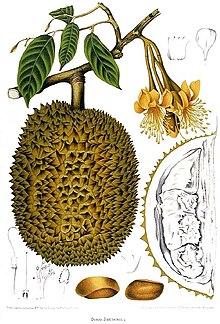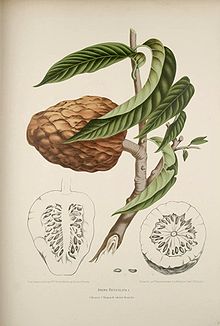| Revision as of 02:08, 28 April 2015 editKasparBot (talk | contribs)1,549,811 edits authority control moved to wikidata← Previous edit | Revision as of 02:19, 3 July 2015 edit undoSer Amantio di Nicolao (talk | contribs)Autopatrolled, Administrators6,279,832 edits add category using AWBNext edit → | ||
| Line 4: | Line 4: | ||
| ==Life== | ==Life== | ||
| Berthe was the daughter of Johannes Wilhelmus van Dolder, a vicar, and his wife Philippina Maria Batenburg. On 11 July 1838 in ], she married Dirk Hoola van Nooten, a judge in ]. Being interested in ], she regularly sent specimens of cultivated plants to botanical gardens in the Netherlands, collected on trips through ] with her husband. She and her husband later moved to New Orleans where they established a female seminary connected to the Protestant Episcopal Church. Personal tragedy struck with her husband's death from yellow fever in 1847, leaving her with a young family of five. She was judged competent by the church and allowed to continue the seminary.<ref>Journal of the Proceedings of the Eighth Annual Convention of the Protestant Episcopal Church of Louisiana (1848)</ref> After a stay in Europe the New Orleans female seminary was re-established in Plaquemine, parish of Iberville, Louisiana, in 1850.<ref>Times Picayune, published as The Daily Picayune; Date: 05-07-1850; Page: 8</ref> She then moved to Galveston. In January 1854 ''The Galveston News'' reported that Mrs. van Nooten's Young Ladies Institute, for which she purchased a 'large and handsome residence,' was operational. In October and November 1855 however the same paper published repeated court orders for B. H. van Nooten, who had argued she was not a resident of Texas, to appear for the Justice of the Peace to answer to creditors. Next we hear of her on the island of Java, to which she travelled with her brother, who was a highly successful merchant in the business of sugar, machines and life insurance. Having arrived in Java she applied for a Government subsidy for setting up a Protestant female seminary to countenance the influence of Roman Catholic seminaries. Probably being refused such support and aware of the vogue in Europe for lavish illustrations of exotic ''flora'', she set about producing 40 plates depicting interesting plant species from Java in which pursuit she followed the precedents set by ] and ]. |
Berthe was the daughter of Johannes Wilhelmus van Dolder, a vicar, and his wife Philippina Maria Batenburg. On 11 July 1838 in ], she married Dirk Hoola van Nooten, a judge in ]. Being interested in ], she regularly sent specimens of cultivated plants to botanical gardens in the Netherlands, collected on trips through ] with her husband. She and her husband later moved to New Orleans where they established a female seminary connected to the Protestant Episcopal Church. Personal tragedy struck with her husband's death from yellow fever in 1847, leaving her with a young family of five. She was judged competent by the church and allowed to continue the seminary.<ref>Journal of the Proceedings of the Eighth Annual Convention of the Protestant Episcopal Church of Louisiana (1848)</ref> After a stay in Europe the New Orleans female seminary was re-established in Plaquemine, parish of Iberville, Louisiana, in 1850.<ref>Times Picayune, published as The Daily Picayune; Date: 05-07-1850; Page: 8</ref> She then moved to Galveston. In January 1854 ''The Galveston News'' reported that Mrs. van Nooten's Young Ladies Institute, for which she purchased a 'large and handsome residence,' was operational. In October and November 1855 however the same paper published repeated court orders for B. H. van Nooten, who had argued she was not a resident of Texas, to appear for the Justice of the Peace to answer to creditors. Next we hear of her on the island of Java, to which she travelled with her brother, who was a highly successful merchant in the business of sugar, machines and life insurance. Having arrived in Java she applied for a Government subsidy for setting up a Protestant female seminary to countenance the influence of Roman Catholic seminaries. Probably being refused such support and aware of the vogue in Europe for lavish illustrations of exotic ''flora'', she set about producing 40 plates depicting interesting plant species from Java in which pursuit she followed the precedents set by ] and ]. | ||
| Her attempts to publish the work were unsuccessful until she acquired the patronage of ], wife of ]. The exceptionally well executed ] were done by Pieter De ], the Belgian lithographer operating from ] in ]. ''"Van Nooten was clearly a more than competent artist, for the splendid tropical plants, with their lush foliage, vividly coloured flowers and exotic fruit, have been depicted with great skill. She managed to accentuate the splendour of each species by adopting a style that combined great precision and clarity with a touch of neo-Baroque exuberance, reveling in the rich forms and colours of the tropics. The reader's eye is immediately captured by the dark leaves, shown furled or crumpled or partly nibbled away by insects, the delicately rendered details of the follicles and seeds, and the heavy clusters of flowers that cascade down the page. The excellent reproduction of the artist's drawings in the form of chromolithographs lends a tactile quality to these striking images."'' — Lucia Tongiorgi Tomasi, ''An Oak Spring Flora.''<ref>{{cite book|last=Tomasi|first=Lucia Tongiorgi|title=An Oak Spring Flora: Flower Illustration from the Fifteenth Century to the Present Time: A Selection of the Rare Books, Manuscripts, and Works of Art in the Collection of Rachel Lambert Mellon|location=Upperville, Va.; New Haven, Conn.|publisher=Oak Spring Garden Library; distributed by ]|year=1997|isbn=0-300-07139-6}}</ref> | Her attempts to publish the work were unsuccessful until she acquired the patronage of ], wife of ]. The exceptionally well executed ] were done by Pieter De ], the Belgian lithographer operating from ] in ]. ''"Van Nooten was clearly a more than competent artist, for the splendid tropical plants, with their lush foliage, vividly coloured flowers and exotic fruit, have been depicted with great skill. She managed to accentuate the splendour of each species by adopting a style that combined great precision and clarity with a touch of neo-Baroque exuberance, reveling in the rich forms and colours of the tropics. The reader's eye is immediately captured by the dark leaves, shown furled or crumpled or partly nibbled away by insects, the delicately rendered details of the follicles and seeds, and the heavy clusters of flowers that cascade down the page. The excellent reproduction of the artist's drawings in the form of chromolithographs lends a tactile quality to these striking images."'' — Lucia Tongiorgi Tomasi, ''An Oak Spring Flora.''<ref>{{cite book|last=Tomasi|first=Lucia Tongiorgi|title=An Oak Spring Flora: Flower Illustration from the Fifteenth Century to the Present Time: A Selection of the Rare Books, Manuscripts, and Works of Art in the Collection of Rachel Lambert Mellon|location=Upperville, Va.; New Haven, Conn.|publisher=Oak Spring Garden Library; distributed by ]|year=1997|isbn=0-300-07139-6}}</ref> | ||
| Line 41: | Line 41: | ||
| ] | ] | ||
| ] | ] | ||
| ] | |||
Revision as of 02:19, 3 July 2015


Berthe Hoola van Nooten (née Bartha Hendrica Philippina van Dolder, 12 October 1817 Utrecht - 12 April 1892 Batavia), was a Dutch botanical artist, noted for her botanical plates illustrating "Fleurs, Fruits et Feuillages Choisis de l'Ile de Java" in 1863-64.
Life
Berthe was the daughter of Johannes Wilhelmus van Dolder, a vicar, and his wife Philippina Maria Batenburg. On 11 July 1838 in Wageningen, she married Dirk Hoola van Nooten, a judge in Paramaribo. Being interested in botany, she regularly sent specimens of cultivated plants to botanical gardens in the Netherlands, collected on trips through Suriname with her husband. She and her husband later moved to New Orleans where they established a female seminary connected to the Protestant Episcopal Church. Personal tragedy struck with her husband's death from yellow fever in 1847, leaving her with a young family of five. She was judged competent by the church and allowed to continue the seminary. After a stay in Europe the New Orleans female seminary was re-established in Plaquemine, parish of Iberville, Louisiana, in 1850. She then moved to Galveston. In January 1854 The Galveston News reported that Mrs. van Nooten's Young Ladies Institute, for which she purchased a 'large and handsome residence,' was operational. In October and November 1855 however the same paper published repeated court orders for B. H. van Nooten, who had argued she was not a resident of Texas, to appear for the Justice of the Peace to answer to creditors. Next we hear of her on the island of Java, to which she travelled with her brother, who was a highly successful merchant in the business of sugar, machines and life insurance. Having arrived in Java she applied for a Government subsidy for setting up a Protestant female seminary to countenance the influence of Roman Catholic seminaries. Probably being refused such support and aware of the vogue in Europe for lavish illustrations of exotic flora, she set about producing 40 plates depicting interesting plant species from Java in which pursuit she followed the precedents set by Maria Sibylla Merian and Elizabeth Blackwell.
Her attempts to publish the work were unsuccessful until she acquired the patronage of Sophia Mathilde, wife of King William III of the Netherlands. The exceptionally well executed chromolithographs were done by Pieter De Pannemaeker, the Belgian lithographer operating from Ledeberg in Ghent. "Van Nooten was clearly a more than competent artist, for the splendid tropical plants, with their lush foliage, vividly coloured flowers and exotic fruit, have been depicted with great skill. She managed to accentuate the splendour of each species by adopting a style that combined great precision and clarity with a touch of neo-Baroque exuberance, reveling in the rich forms and colours of the tropics. The reader's eye is immediately captured by the dark leaves, shown furled or crumpled or partly nibbled away by insects, the delicately rendered details of the follicles and seeds, and the heavy clusters of flowers that cascade down the page. The excellent reproduction of the artist's drawings in the form of chromolithographs lends a tactile quality to these striking images." — Lucia Tongiorgi Tomasi, An Oak Spring Flora.
Although the book was published in a number of editions, Hoola van Nooten died in poverty in Batavia at the age of 74. The Hoola van Nooten family name is today respected in the Netherlands, and is listed in the Nederlands Patriciaat, a register of Dutch families who have played a significant role in Dutch society over the past 150 years.
Hoola van Nooten is denoted by the author abbreviation Hoola van Nooten when citing a botanical name.
References
- Journal of the Proceedings of the Eighth Annual Convention of the Protestant Episcopal Church of Louisiana (1848)
- Times Picayune, published as The Daily Picayune; Date: 05-07-1850; Page: 8
- Tomasi, Lucia Tongiorgi (1997). An Oak Spring Flora: Flower Illustration from the Fifteenth Century to the Present Time: A Selection of the Rare Books, Manuscripts, and Works of Art in the Collection of Rachel Lambert Mellon. Upperville, Va.; New Haven, Conn.: Oak Spring Garden Library; distributed by Yale University Press. ISBN 0-300-07139-6.
- National Library of Australia
- Brummitt, R. K.; C. E. Powell (1992). Authors of Plant Names. Royal Botanic Gardens, Kew. ISBN 1-84246-085-4.